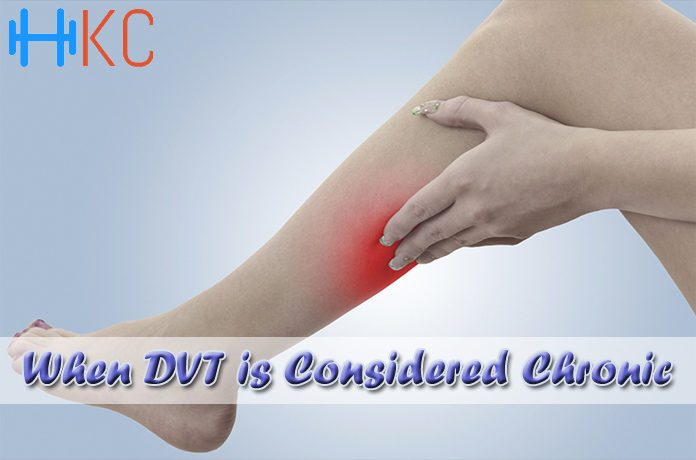Usually the parts of the body all work together successfully for a person to be healthy. However, there are some things that can occur that put patients at risk for complications or conditions that need to be addressed. One example of this is deep vein thrombosis.
When a patient is at risk for deep vein thrombosis or is diagnosed, it is important to seek treatment right away. However, the treatment is different for acute and chronic deep vein thrombosis. Understanding the difference can help make sure a patient receives the right treatment.
What is DVT?
Deep vein thrombosis (DVT) is the creation of a blood clot in a deep vein in the body. Usually, these clots occur in the legs. DVT is dangerous because of the damage that can be done in the deep vein and because the clot can break free and travel to the lungs, causing a pulmonary embolism. A pulmonary embolism can lead to death or other serious complications.
DVT typically occurs due to a combination of decreased blood flow rate, injuries to blood vessel walls, and an increased likelihood to clot. However, there are factors that can contribute to an increased likelihood of developing DVT.
What are warning signs for DVT?
Even though some cases of DVT have no symptoms, there are some warning signs that a patient may have DVT. Symptoms include:
- pain
- swelling
- warmth
- redness
If these symptoms occur (generally in the legs), it is necessary to seek medical attention immediately.
Since some patients do not have any symptoms of DVT, it is also important for patients to recognize risk factors of DVT in order to stay safe.
What are risk factors for DVT?
There are a number of risk factors associated with DVT. Most commonly, patients are at risk for DVT after surgery, particularly if they are immobile. This is why physicians requires patients to become mobile after surgery. If they stay in bed too long, it is more likely that they will develop a clot.
There are other risk factors, as well. Individuals who smoke, who are obese, and who are pregnant are at risk for DVT. After giving birth, women are also at risk. Patients who have a history of DVT may also be at risk for developing it again, particularly if they will be immobile for long periods, such as long-distance travel.
There are some genetic conditions that can also contribute to a likelihood of DVT. Some of these genetic conditions include deficiencies of protein C and antithrombin, among others.
As is the case with most conditions, multiple risk factors compound to increase the likelihood of developing DVT. For example, patients who are pregnant and traveling for a long distance are at higher risk for developing a clot.
How is DVT prevented?
Since the risk factors can be identified, there are measures that can be taken to prevent it from occurring. At the very least, these measures can reduce the likelihood that a clot will develop.
DVT is most often associated with immobility, particularly after surgery or giving birth. Therefore, prevention requires that patients become mobile as quickly as possible after surgery or giving birth. Many hospitals have policies to support this prevention measure.
In addition to mobility, compression socks or stockings can be used for patients at risk for DVT, especially if they have limited mobility. The compression socks are used to improve blood flow in the legs, which reduces the chances of a clot forming in the leg.
In the case of genetic conditions, patients may be given anticoagulants to reduce the likelihood of clotting. Anticoagulants increase the risk of bleeding, but they reduce the chances that a clot will develop. Anticoagulants are also used in cases of surgery after which mobility is not possible. For example, if a patient has knee replacement surgery, walking shortly after surgery is not possible.
How is DVT treated?
If DVT is diagnosed in a patient, there are measures that can be taken to treat the condition. The most common treatment is anticoagulation. This is usually given to patients in the form of drugs, such as LMWH or fondaparinux.
These treatments are given for a limited amount of time based on the needs of the patient. For example, those who developed a clot after surgery typically receive treatment for three months. Unprovoked DVT typically start with a three-month treatment, but may be extended, if needed.
Just as compression socks or stockings are used in prevention for DVT, they can be used for treatment, as well. Typically, these stockings are used along with anticoagulation. It is also important to note that specific types of compression stockings are used for DVT treatment. These stockings are tighter at the ankle than the knee. They are called graduated compression stockings.
Generally, it is recommended that patients use these stockings for approximately two years. It is common for patients to stop using them sooner due to discomfort, but obviously not recommended.
Walking is another common treatment for DVT. Since immobility is a common cause of and risk factor for clots, mobility is a useful treatment. Walking uses the muscles in the legs, which increases blood flow and reduces clotting. However, some patients cannot use this treatment. This includes patients with severe pain, some post-operative patients, or those with pre-existing mobility problems.
In some cases, it is necessary to use more invasive treatments to address the clot. Inferior vena cava (IVC) filters are intended to reduce the likelihood of pulmonary embolism. The device is implanted into the inferior vena cava to prevent the clot from traveling to the lungs. However, this treatment method is not well-established in the medical community at this time.
More often, patients are given an enzyme to break up clots. This treatment is referred to as thrombolysis. Anticoagulation is used more frequently than thrombolysis, but if patients have risk factors that make anticoagulation dangerous, thrombolysis is a great alternative.
Finally, a mechanical thrombectomy can be used to remove the clot using a medical device. However, since this is an invasive technique, it is only used when specific patient criteria are met. As with thrombolysis, anticoagulation is preferred over thrombectomy by medical professionals.
What is the difference between acute and chronic deep vein thrombosis?
Dep vein thrombosis is categorized as either acute or chronic. The difference in categorization is based on the length of time the patient has experienced symptoms. Acute DVT occurs when patients experience symptoms for fourteen days or less. Chronic DVT occurs when patients experience symptoms for at least 28 days. When DVT is present between fourteen and 28 days, it is referred to as subacute DVT.
In addition to the length of time, acute and chronic DVT have physical differences. In acute DVT, the clot is usually softer and more likely to break up and dissolve with the use of anticoagulants.
When the DVT is chronic, the clot is harder and less likely to dissolve easily. The clot can also block the vein and cause long-term damage and problems, even after the clot is dissolved.
When is DVT considered chronic?
DVT is considered chronic when symptoms have been present for at least 28 days. These clots often require extended treatment beyond the initial anticoagulation treatment cycle. They may also require more invasive interventions if the anticoagulation medications do not break up the clot.























